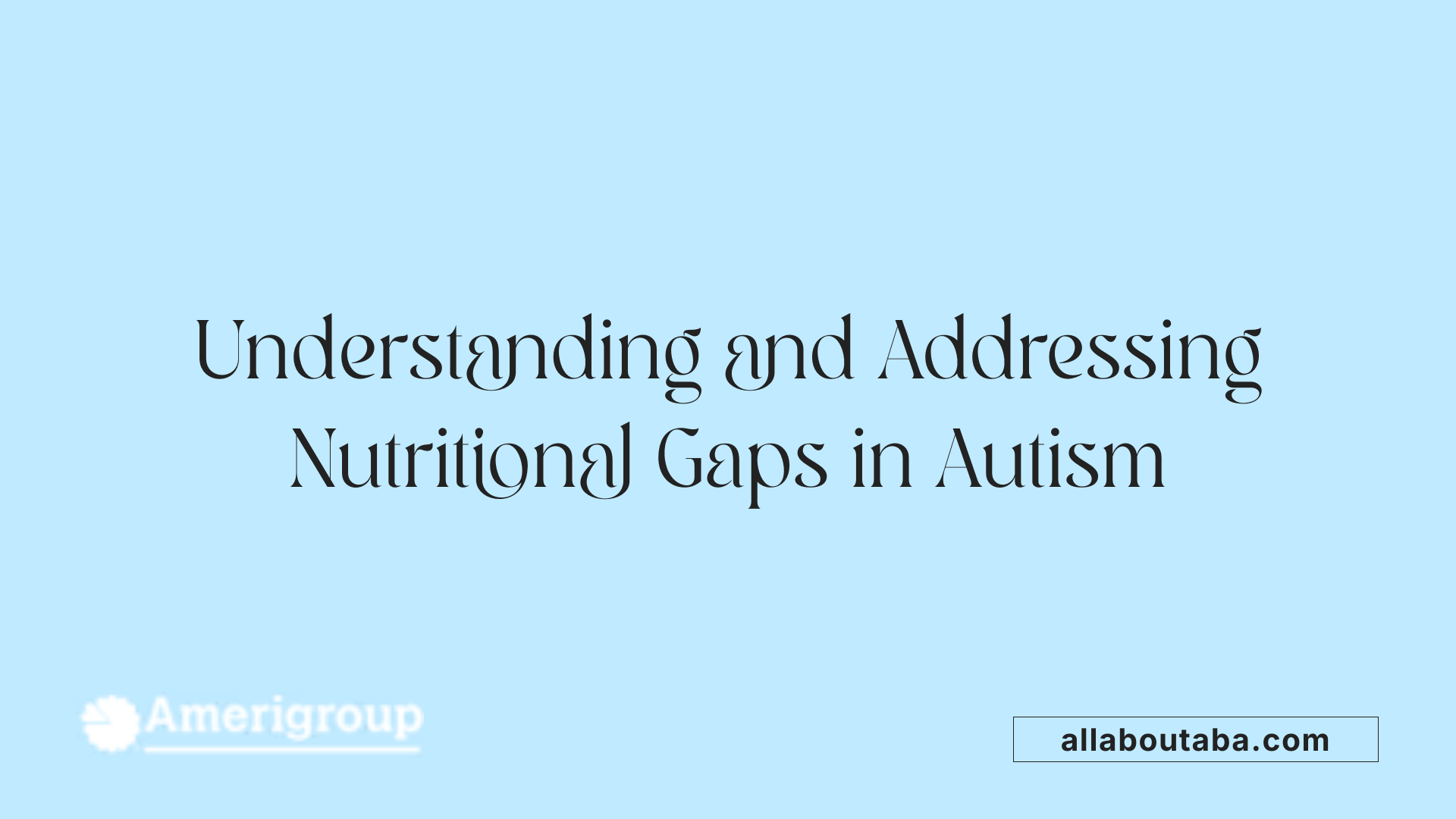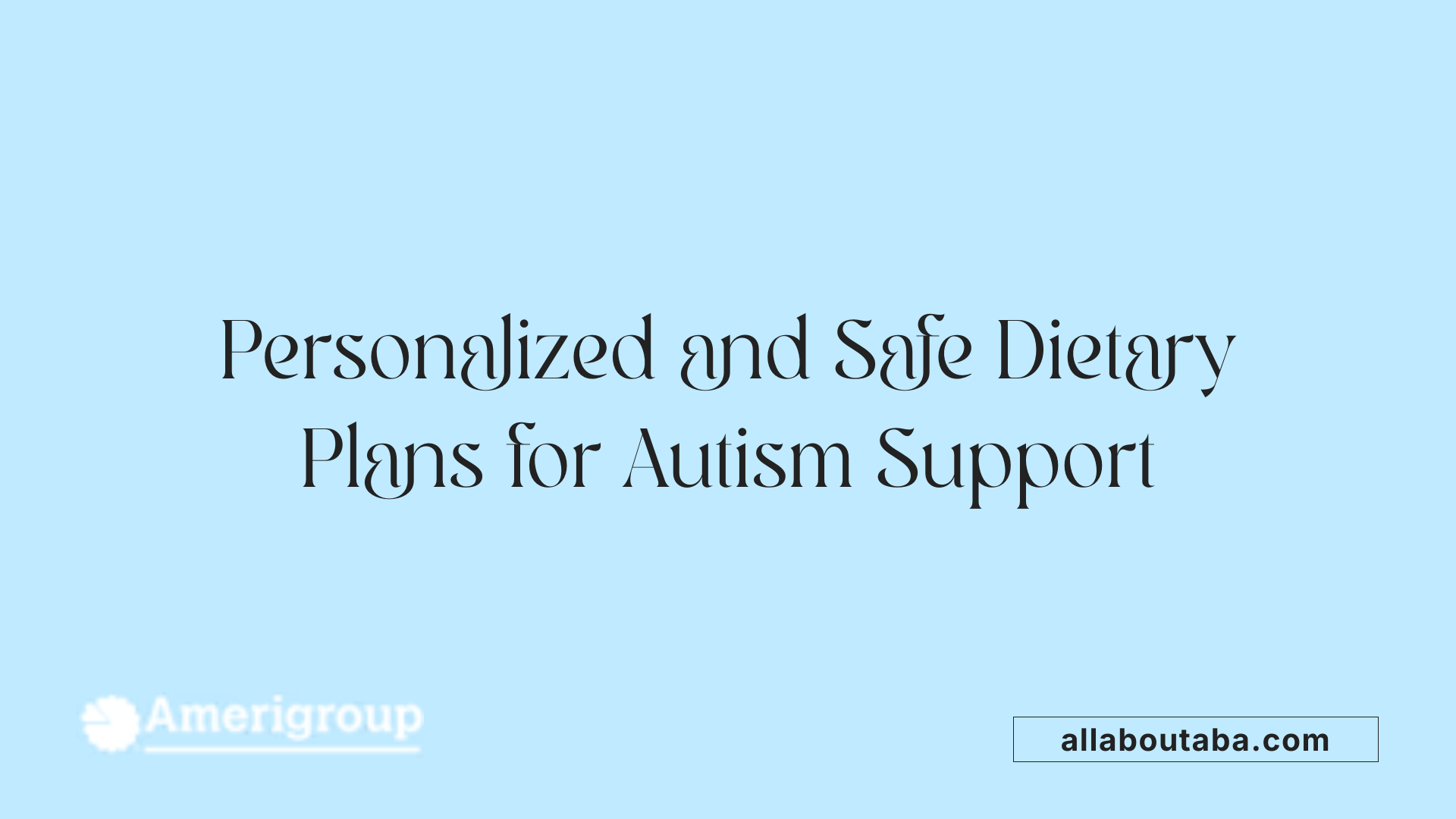The Role Of Diet In Managing Co-Occurring Conditions With Autism
Understanding the Intersection of Diet and Autism Spectrum Disorder
Diet plays a significant role in managing the complex array of co-occurring conditions in individuals with autism spectrum disorder (ASD). From gastrointestinal issues to behavioral challenges, nutrition influences many aspects of health. While the scientific community recognizes the potential benefits of specific dietary interventions, evidence remains mixed, underscoring the importance of personalized, multidisciplinary approaches that prioritize safety and individual needs.
The Significance of Nutrition in Autism Management
What role does nutrition play in symptom management and overall health for autistic individuals?
Nutrition is fundamental to supporting children and adults with autism spectrum disorder (ASD) in maintaining optimal health and managing symptoms effectively. Proper dietary intake influences brain development, immune functioning, and gastrointestinal (GI) health—all areas often affected in ASD.
Many individuals with ASD experience feeding difficulties such as food selectivity, food refusal, and gastrointestinal issues like constipation, diarrhea, and abdominal pain. These challenges can lead to deficiencies in vital nutrients, including vitamin D, B vitamins, zinc, iron, magnesium, calcium, and essential fatty acids like omega-3s and omega-6s, which are crucial for overall health.
Addressing these nutritional gaps is crucial for promoting physical growth, strengthening the immune system, and supporting cognitive functions. Dietary modifications such as adopting gluten-free or casein-free diets, alongside supplementation with vitamins and minerals or probiotics, have been studied for their potential to reduce GI symptoms and behavioral problems.
Incorporating dietary changes is most effective when managed through a collaborative, multidisciplinary approach involving healthcare providers, dietitians, therapists, and families. This teamwork helps tailor interventions to individual needs, ensuring nutritional adequacy while minimizing adverse effects.
Dietary strategies may include gradual introduction of new foods, sensory accommodations, and establishing predictable mealtime routines. Behavioral interventions, such as positive reinforcement and structured mealtimes, support better food acceptance and improve mealtime behaviors.
Beyond addressing deficiencies, these nutritional practices can alleviate gastrointestinal symptoms, reduce hyperactivity, and promote mood stability, contributing to an improved quality of life for individuals with ASD.
Overall, personalized nutrition plans combined with behavioral and medical support play a vital role in managing ASD symptoms, enhancing physical health, and fostering developmental progress.
| Aspect | Focus Area | Additional Notes |
|---|---|---|
| Nutritional Needs | Vitamins, minerals, fatty acids | Address common deficiencies to support health |
| Impact on Brain & Immune Function | Brain development, immune response | Essential nutrients facilitate neurodevelopment and immune resilience |
| Gastrointestinal Health | Gut microbiota, digestive comfort | Dietary interventions may improve GI symptoms and microbiome balance |
| Multidisciplinary Approach | Healthcare team collaboration | Ensures comprehensive and safe dietary management |
| Nutritional Challenges | Food selectivity, sensitivities | Require careful assessment and tailored strategies |
| Dietary Interventions | GFCF diet, ketogenic diet, supplementation | Have shown potential benefits but need supervised application |
| Monitoring and Adjustment | Nutritional status, behavioral response | Regular assessment for optimal outcomes |
Addressing the nutritional aspects of ASD requires a nuanced, individualized plan. Though no one-size-fits-all solution exists, combining dietary, behavioral, and medical strategies can significantly support well-being and developmental progress in autistic individuals.
Gastrointestinal Symptoms and Their Co-Occurrence with Autism

What is the prevalence of gastrointestinal issues in individuals with autism?
Gastrointestinal (GI) problems are significantly more common among children and adults with autism spectrum disorder (ASD) compared to the general population. Research indicates that about 25% of children diagnosed with ASD experience persistent gastrointestinal symptoms. These issues often include a range of digestive disturbances that can interfere with nutrient absorption and overall health.
What types of GI symptoms do individuals with ASD typically experience?
Children with autism frequently report experiencing a variety of GI symptoms such as abdominal pain, diarrhea, constipation, bloating, and nausea. These symptoms can be chronic or episodic and are often associated with feeding difficulties. For instance, constipation affects many children with ASD and can worsen behavioral and mood problems.
How do these GI symptoms impact behavior and health?
Gastrointestinal discomfort can significantly influence behavior, mood, and cognitive function. Discomfort or pain may lead to increased irritability, tantrums, or withdrawal. Furthermore, GI issues can impair vitamin and mineral absorption, leading to nutritional deficiencies. Common deficiencies include vitamin D, B vitamins, zinc, iron, magnesium, calcium, and essential fatty acids, which are crucial for brain development, immune health, and physical growth.
What is the relationship between gut microbiota and autism?
Emerging evidence points to an important connection between altered gut microbiota, known as dysbiosis, and ASD. Children with autism often have an imbalanced gut microbiome, characterized by reduced diversity and the overgrowth of certain bacteria.
Gut dysbiosis may influence neurodevelopment and behavior through the gut-brain-microbiota axis, a complex communication network involving immune, hormonal, and neural pathways. Dysbiosis can promote inflammation, produce harmful metabolites, and affect the integrity of the intestinal barrier, potentially exacerbating autism symptoms.
How can diet influence GI health and ASD symptoms?
Dietary strategies play a crucial role in managing co-occurring GI issues and can impact behavioral symptoms in ASD. Interventions like elimination diets—such as gluten-free and casein-free (GFCF) diets or the specific carbohydrate diet (SCD)—aim to reduce food sensitivities that can trigger GI distress.
Some families report improvements in behavior and digestion following these dietary adjustments, although scientific evidence remains inconclusive. Additionally, diets that promote gut health, such as ketogenic diets, have shown potential benefits by shifting microbiota composition and reducing systemic inflammation.
What nutritional deficiencies are common in ASD?
Many individuals with autism experience deficiencies in vital nutrients, often due to selective eating behaviors or restricted diets. These deficiencies include vitamin D, B6, B12, folate, zinc, iron, magnesium, calcium, and essential fatty acids. Such deficiencies can compromise immune function, hinder cognitive development, and affect overall health.
Addressing these deficiencies via tailored dietary plans, supplementation, and behavioral strategies is essential. For example, omega-3 fatty acids support brain health, while vitamin D levels can influence immune responses and inflammation.
How do dietary interventions and supplements help?
Various dietary supplements like omega-3 fatty acids, vitamin D, probiotics, and antioxidants are under investigation for their potential to support gastrointestinal health and reduce ASD symptoms. For example, probiotics aim to restore healthy gut microbiota balance, potentially alleviating GI distress and influencing behavior.
Camel milk, rich in antioxidants and anti-inflammatory compounds, has shown some promise in reducing oxidative stress and improving social cognition in children with ASD.
How should dietary management be approached?
Management of GI symptoms and related conditions should be individualized and conducted under professional guidance. Close collaboration with healthcare providers—such as dietitians, gastroenterologists, and behavioral therapists—is essential for designing safe and effective dietary plans.
Implementation of any dietary change should be gradual, with regular monitoring to ensure nutritional adequacy and behavioral outcomes. Balanced nutrition, emphasizing vegetables, fruits, healthy fats, and controlled supplementation, helps support physical growth, immune health, and cognitive function.
What role do healthcare professionals and families play?
Building a supportive environment with sensory-friendly dining spaces and routines can help improve food acceptance and reduce anxiety around eating. Partnering with neurodiversity-affirming professionals ensures respect for individual preferences, sensory needs, and co-occurring conditions.
Furthermore, avoid unnecessary or overly restrictive diets unless medically indicated, as they can pose risks of deficiencies or nutritional imbalance. Instead, focus on developing nutrient-rich, enjoyable, and sensory-compatible food options.
| Aspect | Description | Additional Notes |
|---|---|---|
| Common GI Symptoms | Abdominal pain, diarrhea, constipation | Can impair nutrition and behavior |
| Nutritional Deficiencies | Vitamin D, B6, B12, zinc, iron, magnesium, calcium, omega-3 | Impact immune function and brain development |
| Dietary Strategies | GFCF diet, SCD, ketogenic diet | Possible symptom improvement; requires supervision |
| Supplements Under Study | Omega-3, vitamin D, probiotics | May support gut health and behavior |
| Gut Microbiota Role | Dysbiosis linked to symptoms | Modulating microbiota can affect ASD behaviors |
| Professional Guidance | Custom plans, monitoring | Essential for safety and effectiveness |
In conclusion, addressing gastrointestinal symptoms through personalized dietary strategies and nutritional support is a vital component of managing ASD. This approach not only alleviates discomfort but also supports behavioral health and overall well-being, emphasizing a holistic and respectful care paradigm.
Diet's Role in Gut-Brain Axis and Behavioral Symptoms

How is diet connected to gut health and autism symptoms?
Diet plays a vital role in maintaining and improving gut health, especially in individuals with autism spectrum disorder (ASD). The foods we consume influence the balance and diversity of gut microbiota—the community of bacteria and other microorganisms living in the digestive tract. This microbial composition impacts immune responses, gut barrier integrity, and the production of metabolites like short-chain fatty acids, which are essential for healthy brain function.
In many children with ASD, gastrointestinal symptoms such as constipation, diarrhea, and abdominal pain are highly prevalent—ranging from 83% to 91%. These GI issues are often associated with dysbiosis, an imbalance in gut microbiota that may influence neurodevelopment and behavior via the gut-brain axis.
Dietary choices, including the intake of fiber, probiotics, prebiotics, and avoidance of certain trigger foods like gluten and casein, are strategies aimed at restoring microbial balance. For example, high-fiber foods support the growth of beneficial bacteria, while probiotics introduce helpful strains directly into the gut.
Nutrients such as omega-3 fatty acids, vitamins D, B6, B12, folate, zinc, and magnesium are also important for gut barrier health and overall neurological development. These nutrients can help improve mood, focus, social interactions, and reduce behavioral issues.
Various dietary interventions, including gluten-free and casein-free diets, ketogenic diets, and supplementation with specific foods like camel milk, have been explored for their potential to improve gut health and reduce ASD symptoms. While some individuals report benefits, the scientific evidence remains inconclusive, emphasizing the need for personalized approaches overseen by healthcare professionals.
By optimizing diet to promote a healthy gut microbiome, some behavioral and gastrointestinal symptoms can potentially be alleviated. This approach involves careful monitoring and tailoring that aligns with each individual’s sensory sensitivities, nutritional needs, and co-occurring conditions.
Overall, diet’s influence on the gut-brain axis offers a promising domain for managing autism-related symptoms, especially gastrointestinal discomfort and behavioral challenges. However, further research is necessary to establish clear, evidence-based dietary guidelines that can be widely implemented.
Influence of diet on microbiota composition
The microbiota composition can be significantly shaped by diet, with high-fiber diets encouraging beneficial bacteria such as Bifidobacterium and Akkermansia. Conversely, diets rich in processed foods, sugars, and artificial additives may promote dysbiosis.
Microbiota’s impact on neurodevelopment and behavior
Emerging research suggests that the microbiota influences neurodevelopment and behavior through several pathways, including modulation of immune responses, production of neuroactive compounds, and interaction with the vagus nerve.
Probiotics, prebiotics, and dietary fibers
Probiotics are live microorganisms that confer health benefits by restoring microbial balance. Prebiotics are dietary fibers that support the growth of beneficial bacteria. Including these in the diet, along with a variety of fiber-rich foods, can support a healthier gut environment conducive to better behavioral outcomes.
| Aspect | Role | Impact on ASD | Supporting Foods/Interventions |
|---|---|---|---|
| Microbiota Balance | Maintains immune and gut health | Reduced GI symptoms, improved mood | Probiotic-rich foods (yogurt, kefir), prebiotic fibers (onions, garlic) |
| Nutrient Support | Provides essential vitamins and minerals | Supports brain development and function | Fish oils (omega-3), leafy greens, fortified foods |
| Dietary Patterns | Influence overall microbiota | May reduce inflammation and behavioral issues | Whole foods, avoiding processed foods |
Evaluation of Dietary Interventions for Autism-Related Conditions

What does current research say about different dietary approaches for children with ASD?
Several dietary strategies have been explored to manage autism symptoms and associated gastrointestinal issues. Among the most common are the gluten-free and casein-free (GFCF) diet, ketogenic diet, specific carbohydrate diet (SCD), elimination of artificial food dyes, Candida diet, and supplementation with vitamins, minerals, and omega fatty acids.
The GFCF diet removes gluten and casein, based on the hypothesis that these proteins may influence brain function and gastrointestinal health in ASD. Some parents report improvements in behavior and digestion, but scientific evidence remains mixed. The ketogenic diet (KD), characterized by high fat and very low carbohydrate intake, has shown potential benefits such as reduced tantrums and improved social interactions, possibly through effects on gut microbiota and metabolic pathways.
Other interventions like the Candida diet focus on eliminating certain fungi-associated foods, while diets like SCD aim to reduce complex carbs to promote gut health. Some studies also investigate the effects of camel milk, which contains antioxidants and anti-inflammatory properties, possibly contributing to behavioral improvements.
How effective are various dietary interventions for autism-related co-occurring conditions?
Research indicates that the effects of dietary interventions on autism core symptoms are generally moderate and variable. Meta-analyses suggest that diet therapies such as GFD and KD can result in improvements in social behaviors and reduction of gastrointestinal symptoms. For instance, GFD has been associated with better social interactions, with some studies reporting a standard mean difference indicating modest positive effects.
Similarly, the ketogenic diet has demonstrated a significant impact on core ASD symptoms, notably in behavioral flexibility and social engagement. However, these diets do not appear to significantly influence cognition, communication, or stereotypical behaviors. Moreover, some clinical trials have observed no notable effects, emphasizing that individual responses can vary considerably.
Although some children experience notable benefits, others see little to no change. The variability underscores the necessity of personalized approaches, considering each child's unique physiology, sensitivities, and nutritional needs.
What challenges and risks are associated with implementing these diets?
Implementing restrictive diets such as GFCF or KD presents certain challenges. Adherence can be difficult due to the restrictive nature, which may impact family routines and nutritional adequacy. There is a risk of nutritional deficiencies, particularly if diets are not carefully planned.
Common deficiencies include vitamins D, B6, B12, folate, zinc, iron, magnesium, calcium, and essential fatty acids. These deficits can compromise growth, immune function, and cognitive development if unaddressed. Side effects such as constipation, gastrointestinal discomfort, and behavioral challenges related to diet restrictions can also occur.
Furthermore, the evidence supporting these diets is often limited by methodological issues, with many studies lacking large sample sizes or control groups. This makes it difficult to draw definitive conclusions and emphasizes the importance of supervised implementation.
Which nutrients are often deficient in children with ASD, and how can supplementation help?
Children with ASD frequently experience deficiencies in nutrients vital for overall health and brain function. Vitamin D is commonly low, which can impair immune function and neurodevelopment. Omega-3 fatty acids, crucial for brain structure and function, are often insufficient, especially in children with restrictive diets.
Other deficiencies include B vitamins (B6, B12), folate, zinc, iron, magnesium, and calcium. These nutrients are essential for growth, neurotransmitter synthesis, and immune health.
Supplementation with targeted nutrients like vitamin D, methylcobalamin (a form of B12), L-carnitine, and omega fatty acids has been investigated for potential benefits, including improved behavioral regulation, reduced hyperactivity, and enhanced cognitive function.
Proper assessment through blood tests and professional guidance are essential before undertaking supplementation to avoid excess intake and potential toxicity.
What is the importance of a multidisciplinary approach in dietary management?
Effective dietary management in ASD should be part of a holistic, multidisciplinary treatment plan. Collaboration among dietitians, healthcare providers, therapists, and families ensures that nutritional needs are met without compromising health.
Early intervention and ongoing monitoring are vital to adjust dietary plans as needed and to prevent nutritional deficiencies. Behavioral strategies such as gradual food introduction, positive reinforcement, and sensory-friendly mealtime environments support better food acceptance.
Supporting food autonomy and respecting individual preferences reduce mealtime anxiety and improve adherence.
Summarizing the evidence and best practices
| Diet Strategy | Evidence Level | Main Benefits | Risks and Challenges | Notes |
|---|---|---|---|---|
| GFCF diet | Mixed results | Behavioral, GI improvements | Nutritional deficiencies, compliance | Use only under supervision |
| Ketogenic diet | Moderate evidence | Behavioral, metabolic improvements | Nutrient gaps, adherence issues | Requires medical oversight |
| SCD | Limited evidence | Gut health | Restrictive, difficult to maintain | Best with dietitian support |
| Supplementation (Omega-3, Vitamin D) | Growing evidence | Brain health, mood regulation | Overdose risks | Tailored to individual needs |
Recently emerging research emphasizes the microbiota-gut-brain connection, suggesting that dietary modulation of gut bacteria via probiotics, fermented foods, or specific diets may influence behavioral symptoms. Nevertheless, large-scale, robust studies are needed to establish definitive guidelines.
In conclusion, dietary interventions offer promise for managing some aspects of ASD and co-occurring gastrointestinal issues. However, personalized planning, professional supervision, and integration within a comprehensive treatment plan are essential for safety and effectiveness.
Nutritional Deficiencies in Autism Spectrum Disorder

What are common deficiencies seen in individuals with autism?
Children and adults with autism spectrum disorder (ASD) frequently experience deficiencies in several essential nutrients. Notably, vitamin D, vitamin B6, B12, folate, zinc, iron, magnesium, calcium, and omega-3 fatty acids are often lacking in their diets or due to absorption issues.
These deficits can result from restricted food intake, selectivity, or gastrointestinal (GI) problems that impair nutrient absorption. For example, many children with ASD have limited diets due to sensory sensitivities, which can eliminate a variety of nutrient-rich foods. Additionally, GI disturbances such as constipation, diarrhea, and malabsorption can further contribute to deficiencies, impacting overall health.
How do deficiencies affect health and behavior?
Nutritional gaps can influence various aspects of health, including immune function, physical growth, and cognitive development. Deficiencies in vitamin D and omega-3 fatty acids, for instance, have been linked to increased behavioral issues like hyperactivity and irritability.
Vitamin B12 and folate are crucial for brain development and function, and their insufficiency may exacerbate learning difficulties or mood disturbances. Mineral deficiencies such as zinc and magnesium can impair immune response and reduce the ability to cope with stress, further affecting behavioral regulation.
What are the causes of these deficiencies?
The primary causes include restrictive diets often seen in children with ASD, which limit intake of various nutrient-dense foods. Sensory sensitivities may lead individuals to reject textures, tastes, or smells of certain foods, resulting in limited dietary variety.
Gastrointestinal issues also play a significant role. Conditions like leaky gut, dysbiosis, or malabsorption syndromes prevent the efficient absorption of nutrients, compounding deficiencies.
How can deficiencies be addressed?
Addressing nutrient gaps involves a combination of dietary adjustments and targeted supplementation. Collaborating with dietitians or healthcare providers is essential to develop customized plans that ensure nutritional adequacy.
Dietary strategies include introducing a variety of sensory-friendly foods gradually, utilizing visual aids, and establishing structured mealtime routines. These approaches help improve food acceptance in children with selective eating.
Supplementation can help fill nutritional gaps, especially when dietary modifications are insufficient or impractical. Vitamin D, omega-3 fatty acids, B-complex vitamins, and minerals like zinc and magnesium are commonly supplemented based on individual needs.
Monitoring levels regularly ensures that nutritional interventions are effective and safe. Combining dietary and supplement strategies can support physical health, immune function, and cognitive development, ultimately contributing to better overall outcomes.
| Nutrient | Common Deficiency States | Impacts | Strategies to Address |
|---|---|---|---|
| Vitamin D | Limited sun exposure, restricted diet | Immune dysfunction, mood issues, bone health | Supplementation, sunlight exposure |
| Omega-3 (DHA/EPA) | Limited intake of fatty fish, restricted diets | Brain development, hyperactivity, mood | Fish oil supplements, dietary increase |
| Vitamin B6 & B12 | Restricted diets, absorption issues | Cerebral function, mood regulation | B vitamin supplements, diet diversity |
| Zinc & Magnesium | Restricted diet, GI malabsorption | Immune health, neurological function | Mineral supplements, dietary sources |
| Iron & Calcium | Poor dietary intake, GI issues | Anemia, bone density, muscle function | Iron supplements, calcium-rich foods |
What is the role of nutrition in managing co-occurring conditions?
Proper nutrition is vital for managing co-occurring conditions often seen in ASD, such as gastrointestinal problems, mood disorders, and behavioral challenges. Addressing nutritional deficiencies through tailored diets or supplementation can improve GI symptoms, potentially reducing behavioral issues linked to discomfort.
Incorporating nutrient-rich, sensory-friendly foods supports not only physical health but also enhances cognitive and social functioning. Nutritional strategies should be integrated within a multidisciplinary approach, including behavioral interventions, speech therapy, and medical treatment, for comprehensive care.
Final note
While nutritional interventions show promise, current research indicates that they should be personalized, carefully monitored, and used alongside other therapies. There's no one-size-fits-all solution, and ongoing evaluation ensures that interventions meet individual needs without causing nutritional imbalances.
An individualized approach, guided by healthcare professionals, can optimize health outcomes, support developmental progress, and improve quality of life for individuals with autism.
Addressing Feeding Difficulties and Sensory Sensitivities
Why is evidence-based dietary guidance important to support sensory sensitivities and eating challenges in autism?
Children with autism spectrum disorder (ASD) frequently face feeding difficulties and sensory sensitivities that can significantly impact their nutrition and overall health. These sensitivities, which include strong reactions to textures, smells, tastes, and visual aspects of food, often lead to food selectivity, refusals, and limited diets that risk nutritional deficiencies.
Implementing evidence-based dietary guidance is essential to ensure that children receive balanced nutrition while accommodating their sensory needs. Such guidance helps caregivers and health professionals develop strategies tailored to individual preferences, promoting acceptance of a broader range of nutrient-rich foods. For example, gradually introducing new textures or flavors in a supportive, predictable setting can reduce anxiety around eating.
Creating a structured, sensory-friendly mealtime environment—such as using calming lighting, minimizing distractions, or offering familiar foods—can help decrease sensory overload and enhance food acceptance. Collaborative efforts involving dietitians, occupational therapists, and behavioral specialists are vital in designing interventions that are both effective and respectful of the child’s autonomy.
Research-backed practices emphasize positive reinforcement and routine establishment, which foster trust and improve mealtime experiences. By focusing on a supportive environment and gradual exposure, these strategies encourage healthier eating patterns and help close nutritional gaps.
Overall, adherence to scientific evidence ensures that interventions do not inadvertently cause harm, such as promoting restrictive diets that may worsen deficiencies. It also upholds a respectful approach that values the child's sensory preferences, supporting their well-being without stigmatizing or coercing.
This comprehensive, personalized method not only addresses immediate feeding challenges but also promotes long-term healthy eating habits, contributing to overall physical, cognitive, and emotional development in children with ASD.
The Impact of Food Selectivity and Feeding Challenges
What is the prevalence of food selectivity in children with autism?
Children with autism Spectrum Disorder (ASD) frequently experience feeding difficulties, which are marked by high levels of food selectivity. Studies suggest that a significant portion of children with ASD, often between 50% to 90%, demonstrate strong preferences for certain foods while refusing others. This food selectivity can be driven by sensory sensitivities, such as hypersensitivity to textures, smells, and tastes, which are common among autistic individuals. As a result, many children with ASD may have very restrictive diets, limited food variety, and persistent refusal of new or unfamiliar foods.
What are common behavioral patterns, such as food refusal and pickiness?
Food refusal and pickiness are typical behaviors observed in children with ASD. These behaviors can manifest as extreme selectivity, where children might reject foods based on textures, colors, or smells. They may also exhibit behaviors like fussing during mealtime, leveraging routines to control food intake, or engaging in stimming behaviors related to eating. Food refusal can be compounded by sensory sensitivities, anxiety, or previous negative experiences with certain foods. Additionally, some children might engage in behaviors like biting, gagging, or spitting, which further complicate mealtime routines.
What are the nutritional consequences of feeding challenges?
Feeding difficulties often lead to nutritional deficiencies in children with ASD. These deficiencies can include vitamin D, B6, B12, folate, zinc, iron, magnesium, calcium, and essential fatty acids like omega-3 and omega-6. Such gaps can have wide-ranging impacts, potentially affecting physical growth, immune function, and cognitive development. Restricted diets may also result in caloric insufficiency, leading to weight loss or failure to thrive, as well as GI issues like constipation or diarrhea, which often co-occur with feeding problems.
What strategies are effective for managing feeding difficulties?
Behavioral and Therapeutic Approaches
Feeding therapy, incorporating behavioral strategies such as gradual exposure and positive reinforcement, can promote food acceptance. For example, therapists might introduce new foods slowly, pair them with preferred items, or use visual cues to motivate trying new options.
Creating a Supportive Mealtime Environment
A sensory-friendly environment can significantly improve mealtime experiences. This includes establishing predictable routines, minimizing sensory overload (dim lighting, reduced noise), and offering a consistent set of preferred foods.
Involving Families and Professionals
Collaboration among families, dietitians, occupational therapists, and behavioral specialists is crucial. Tailoring interventions to individual sensory preferences and dietary needs helps promote a healthy relationship with food.
Sensory Integration and Environmental Modifications
Sensory integration strategies, such as textured food exposure or proprioceptive input, might reduce sensitivities. Simplified meal preparations and flexible mealtimes can also reduce anxiety and improve intake.
How do dietary interventions fit into overall management?
Dietary interventions like gluten-free, casein-free diets, the ketogenic diet, and elimination of artificial dyes are often explored by families aiming to manage core symptoms or gastrointestinal issues. While some studies report improvements in behavior and GI symptoms, the evidence remains mixed, and such diets should be implemented cautiously under professional supervision. Importantly, these interventions are most effective when integrated into a comprehensive treatment plan that includes behavioral therapy, speech therapy, and medical management.
What is the importance of personalized approaches?
Given the variability in sensitivities, nutritional status, and behavioral patterns, personalized intervention plans are essential. Tailoring diets, using sensory strategies, and adjusting approaches based on ongoing assessments ensure safety and maximize benefits.
Below is a summary table highlighting main feeding challenges and management strategies:
| Challenge | Behavioral Pattern | Management Strategy | Expected Outcome |
|---|---|---|---|
| Food selectivity | Refusal of new or certain foods | Gradual exposure, positive reinforcement | Increased food variety |
| Sensory sensitivities | Rejection of textures or smells | Sensory integration, sensory-friendly environment | Reduced mealtime anxiety |
| Nutritional deficiencies | Limited nutrient intake | Nutritional assessment, supplementation, diverse diets | Improved growth and health |
| Behavioral issues during meals | Fussing, gagging, spitting | Routine establishment, behavioral therapy | Better mealtime cooperation |
| Food aversion or anxiety | Dislike of unfamiliar foods | Visual supports, structured mealtime routines | Reduced anxiety, better intake |
Addressing feeding issues in children with ASD requires a comprehensive, gentle, and individualized approach. Emphasizing respect for sensory sensitivities and fostering positive mealtime experiences are fundamental to ensuring nutritional adequacy and supporting overall health.
The Role of Sensory Environment in Mealtime Success
Why is evidence-based dietary guidance important to support sensory sensitivities and eating challenges in autism?
Children with autism often experience heightened sensitivities to sensory stimuli such as textures, smells, tastes, temperatures, and visual appearances. These sensitivities can significantly influence their food choices and eating behaviors, often leading to limited diets and nutritional deficiencies.
Providing guidance rooted in scientific research helps caregivers and professionals develop tailored strategies that accommodate these sensory challenges. For example, understanding that a child may refuse foods with certain textures or smells enables the implementation of gradual food introduction techniques. This approach allows for the expansion of food acceptance while minimizing anxiety.
Creating a structured, predictable mealtime environment is essential. Calm, sensory-friendly spaces with minimal distractions can help reduce overstimulation and make eating a more positive experience.
Using visual supports, such as picture schedules or visual menus, can assist children in understanding mealtime routines and setting expectations. Flexible routines that adapt to individual sensory needs and preferences encourage participation and reduce resistance.
Managing sensory overload is critical. Techniques such as offering foods at appropriate temperatures, using soft or familiar textures, and providing sensory tools or calming stimuli can help mitigate anxiety.
Involving dietitians, occupational therapists, and behavioral specialists ensures that dietary plans are holistic and consider the child's sensory profile, nutritional needs, and behavioral strategies. This interdisciplinary approach promotes healthy eating patterns while respecting individual sensory sensitivities.
Research-backed practices emphasize the importance of patience, consistency, and positive reinforcement. Over time, this fosters food acceptance, improves nutritional intake, and contributes to overall well-being.
By prioritizing evidence-based methods, caregivers can create supportive mealtime environments that respect sensory differences, reduce food refusal, and encourage healthier eating habits—ultimately leading to better health outcomes and enhanced quality of life for children with autism.
Emerging Therapies and Future Directions in Dietary Management
What are some novel dietary approaches being explored for ASD?
Recent research has shown interest in unconventional dietary options like camel milk supplementation and new diets such as the ketogenic diet. Camel milk is rich in antioxidants and anti-inflammatory components, which may help reduce oxidative stress and inflammation—factors associated with ASD symptoms.
The ketogenic diet (KD), originally used for epilepsy management, has also been studied in children with ASD. It influences gut microbiota composition, promotes the growth of beneficial bacteria such as Akkermansia and Blautia, and reduces pro-inflammatory cytokines. Some studies have reported improvements in social behaviors, cognition, and reductions in hyperactivity.
Other emerging approaches include new elimination diets aimed at identifying food sensitivities and microbiota-targeted therapies, such as probiotics, which can help restore gut health and potentially influence brain function.
What are the potential benefits and risks of these new therapies?
Potential benefits of novel diets and supplements include improved gastrointestinal health, better behavioral regulation, and possibly enhanced cognitive functioning. For instance, camel milk has been associated with decreased inflammation and oxidative stress, while the ketogenic diet may reduce tantrums and improve social interactions.
However, these approaches also present risks. Restrictive diets like KD can lead to nutritional deficiencies, including vitamins and minerals, if not carefully monitored. Camel milk, although promising, is expensive and not readily accessible for all families, and its long-term effects are not yet fully understood.
Moreover, the heterogeneity of ASD makes predicting individual responses challenging. Without rigorous, large-scale clinical trials, it remains difficult to confirm the safety and efficacy of these therapies definitively.
Why is further research and clinical trials necessary?
Current evidence supporting novel dietary interventions is promising but limited. Many studies are small, have methodological variability, or lack control groups, which hampers the ability to draw firm conclusions.
Larger, well-designed randomized controlled trials are essential to determine optimal protocols, identify appropriate candidates, and assess long-term outcomes. Additionally, research needs to explore personalized approaches, considering individual sensitivities, co-occurring conditions, and nutritional status.
Further studies should also evaluate the safety profiles of these diets, their impacts on overall health, and their effects on core ASD symptoms and comorbidities.
How can dietary management be integrated into broader autism care?
Effective management of ASD requires a multidisciplinary approach that combines dietary strategies with behavioral, educational, and medical interventions. Dietary plans should be individualized, developed in collaboration with healthcare professionals like dietitians and physicians, to ensure nutritional adequacy and address specific sensitivities.
Part of integration involves regular monitoring of nutritional status, growth, and behavioral progress. Behavioral strategies such as gradual exposure, positive reinforcement, and sensory-friendly mealtimes can improve acceptance and reduce mealtime stress.
Furthermore, support for families should include education about the limitations and potential risks of restrictive diets, emphasizing that dietary interventions are adjuncts—not replacements—for evidence-based therapies like Applied Behavior Analysis (ABA) and speech therapy.
By combining nutritional management with comprehensive autism care, it is possible to promote better health, reduce gastrointestinal and behavioral issues, and support overall development.
| Aspect | Description | Additional Details |
|---|---|---|
| Dietary approaches | Camel milk, ketogenic diet, novel elimination diets | Potential for symptom improvement but require cautious application |
| Benefits | Reduced inflammation, behavioral gains, gut health | Promising but need confirmation through research |
| Risks | Nutritional deficiencies, accessibility issues, unknown long-term effects | Careful planning and professional guidance essential |
| Research needs | Larger, randomized trials, personalized protocols | Focused on safety, efficacy, and individual response |
| Integration | Multidisciplinary, collaborative, supportive environment | Ensures safety, nourishment, and behavioral gains |
As research progresses, the hope is that these new dietary options will become more evidence-based and tailored to individual needs, ultimately enhancing the overall quality of life for those with ASD.
Guidelines for Personalized and Safe Dietary Interventions

Why is evidence-based dietary guidance important to support sensory sensitivities and eating challenges in autism?
Supporting children with autism through dietary interventions requires a careful, research-informed approach. Many autistic individuals experience sensory sensitivities—such as heightened reactions to textures, smells, tastes, and appearances—that can significantly influence their eating habits. These sensitivities often lead to food selectivity, food refusals, and nutritional gaps, which may affect growth, immune function, and overall health.
Implementing evidence-based guidance ensures that dietary strategies are tailored to individual needs while minimizing risks. For example, understanding the sensory factors at play allows dietitians and caregivers to develop gradual food introduction plans, use sensory-friendly environments, and incorporate preferred textures to enhance acceptance of diverse, nutrient-rich foods.
Creating a structured, predictable mealtime environment helps reduce anxiety associated with food intake. Techniques such as visual supports, timers, and consistent routines ground the eating process, making it more manageable for children with sensory sensitivities.
Interdisciplinary collaboration is fundamental. Dietitians working alongside occupational therapists and behavioral specialists can design comprehensive plans that respect each child's sensory profile, behavioral preferences, and nutritional needs.
Research-backed practices also help avoid harmful or unproven diet trends that lack scientific support, such as restrictive elimination diets without medical indication, which can lead to nutritional deficiencies.
In summary, evidence-informed guidance in dietary management for autism creates a supportive, safe, and effective path towards improving eating behaviors, ensuring nutritional adequacy, and supporting overall health and development.
How should diets be tailored to individual needs?
Personalized dietary plans should consider a child's specific sensory sensitivities, food preferences, medical history, and co-occurring conditions.
This involves initial assessments by healthcare professionals to identify food sensitivities and nutritional deficiencies. Based on these findings, dietitians can develop menus that include tolerated, nutrient-dense foods while gradually introducing new textures and flavors.
Flexibility is key; accommodating preferred foods can serve as a foundation for expanding diets. For example, if a child prefers smooth textures, pureed or blended foods might be used to increase variety.
Incorporating culturally relevant foods and respecting individual food choices fosters participation and compliance.
Why is monitoring health and nutritional status vital?
Regular assessment is crucial to ensure nutritional adequacy and detect deficiencies early. Blood tests for vitamins, minerals, and markers of inflammation can guide supplementation or dietary adjustments.
Periodic growth measurements help verify that dietary plans support healthy development.
Monitoring gastrointestinal symptoms, behavioral changes, and nutritional intake provides feedback for ongoing modifications.
How can unproven diet trends be avoided?
Parents and caregivers should rely on guidance from licensed healthcare professionals when considering dietary changes.
Many popular diets, such as gluten-free, casein-free, or ketogenic diets, lack consistent scientific evidence and may cause nutritional imbalances if implemented improperly.
Professional supervision ensures that any restrictive diet is nutritionally balanced and appropriate for the child's unique needs.
Educational resources from reputable organizations can also inform families about proven practices versus unsupported trends.
What role does collaboration with healthcare professionals play?
Close cooperation among dietitians, pediatricians, occupational therapists, and behavioral specialists ensures a holistic approach.
Such teamwork allows for individualized plans that incorporate dietary strategies, sensory integration, behavioral interventions, and medical management.
This coordinated effort enhances the safety, effectiveness, and sustainability of dietary interventions.
In conclusion, developing personalized, evidence-based dietary programs supported by multidisciplinary collaboration is essential for fostering healthy eating in children with autism. This approach helps mitigate feeding difficulties, reduce nutritional deficiencies, and promote overall well-being.
To explore further information and current best practices, conducting a search with the phrase "Safe dietary implementation in ASD" is recommended. This will provide updated, research-supported resources and guidelines that can inform clinical and caregiving decisions.
Summing Up the Role of Diet in Autism Management
Diet plays a vital supportive role in managing co-occurring conditions and improving the quality of life for individuals with autism spectrum disorder. While evidence supports certain dietary strategies, individualized care, ongoing monitoring, and professional guidance are paramount. Emerging research into the gut-brain axis and microbiota offers promising avenues for future therapies, but current approaches should be integrated within a comprehensive, multidisciplinary framework to ensure safety and effectiveness.
References
- A Review of the Nutritional Approach and the Role ...
- Nutritional management and autism spectrum disorder
- The Role of Diet in Managing Autism Symptoms - Dream Big
- The Role of Diet in Autism Care - Childwise ABA
- Efficacy and Safety of Diet Therapies in Children With ...
- Exploring Dietary Interventions in Autism Spectrum Disorder
- The role of co-occurring conditions and genetics in ...
- Brain-gut-brain axis, nutrition, and autism spectrum disorders
- Autism and Food: Supporting Sensory Needs & Autonomy
Other articles
Recent articles

Best Practices For Autism-Friendly Fitness And Recreation Centers

Best Ways To Promote Healthy Social Media Use For Autistic Teens

How To Help Autistic Children Cope With Public Speaking

Autism And Strategies For Managing Unexpected Changes

Best Podcasts About Autism For Parents And Educators

Autism And The Impact Of Seasonal Changes On Behavior

The Role Of Diet In Managing Co-Occurring Conditions With Autism

Sleep Challenges In Autism And Practical Solutions

Best Ways To Build Daily Routines For Autistic Children

Best Practices For Supporting Autistic Entrepreneurs

Autism And Strategies For Navigating Large Social Gatherings

Adaptive Sports And Recreational Activities For People With Autism

Autism And The Benefits Of Story-Based Learning Activities

Understanding The Role Of Play In Autism Development

Autism And The Impact Of Environmental Noise On Learning

How To Create Autism-Friendly Community Spaces

Autism And Chronic Health Conditions: What To Know

The Role Of Care Managers In Autism Life Planning

How To Teach Social Boundaries To Autistic Children

How Autistic Individuals Experience Empathy Differently

How To Support Autistic Employees In Remote Work Settings

Autism And The Relationship Between Motor Skills And Learning

How To Create Community Resource Guides For Autism Families

How To Teach Daily Living Skills To Autistic Teens

Autism And The Impact Of Mind-Body Practices On Stress Reduction

Autism And The Benefits Of Outdoor Group Activities

How To Create Autism-Friendly Sensory Paths In Schools

Best Practices For Autism-Friendly Park And Recreation Areas

Autism And Strategies For Reducing School Refusal

Supporting Autistic Individuals In Public Speaking

The Role Of Diet In Managing Autism Symptoms

The Benefits Of Gardening Clubs For Autism Social Development

How To Prepare Autistic Children For Dental Visits

Autism And Employment: Career Paths That Work

Best Practices For Autism-Friendly Hotels And Lodging

The Impact Of Screen Time On Autism Development

Autism Screening Tools For Early Childhood

The Role Of Physical Exercise In Autism Therapy

Best Strategies For Supporting Autistic College Students

The Role Of Technology In Autism Early Detection

Sensory-Friendly Classroom Design Ideas For Autistic Students

The Role Of Speech Therapy In Building Social Communication Skills

Best Strategies For Handling Autistic Burnout In Adults

Autism And The Importance Of Predictability In Routine

Autism And Peer Education: Teaching Acceptance In Schools

Best Practices For Sensory-Friendly Libraries And Reading Rooms

Self-Advocacy Skills For Autistic Adults

The Role Of Technology In Autism Peer Communication

Promoting Physical Activity In Children With Autism

How To Prepare Autistic Children For Medical Procedures

The Role Of Social Media In Autism Advocacy And Awareness

The Impact Of Sensory Rooms In Public Facilities For Autism

How To Create An Autism-Friendly Holiday Celebration

Best Practices For Inclusive Education For Autistic Students

Autism And Mental Health: Recognizing Signs Of Distress

Best Practices For Sensory-Friendly Waiting Rooms

The Role Of Teachers In Early Autism Red Flag Identification

Autism-Friendly Housing Design Features

Autism-Friendly Housing Design Features

How Environmental Modifications Improve Autism Outcomes

Autism And Technology-Based Learning Tools

Supporting Autistic Children Through Changes In Routine

The Link Between Autism And Working Memory Challenges

Best Practices For Autism-Friendly Cooking Classes

Autism And The Benefits Of Structured Music Lessons

Best Books To Teach Kids About Autism Acceptance

Sensory Diets And Their Benefits For Autism Management

How To Prepare Autistic Teens For Driver’s Education

How To Teach Autistic Teens About Healthy Relationships

The Role Of Visual Prompts In Building Daily Habits For Autism

Addressing Sleep Regression In Children With Autism

Understanding Social Stories And How They Help Autistic Children

Navigating Insurance Coverage For Autism Therapy Services

How To Prepare Autistic Adults For Independent Travel

Supporting Autistic Individuals In Volunteer Work

How Mindfulness Practices Can Support Autism Well-Being

Understanding Hyperfocus And Special Interests In Autism

Understanding Stimming As A Self-Regulation Tool

Sensory-Based Interventions For Autism At Home

Best Ways To Introduce Self-Advocacy In Autistic Teens

Best Ways To Support Autistic Employees In Customer Service Roles

Best Practices For Autism-Friendly Volunteer Programs

Autism And The Benefits Of Sensory Play For Emotional Growth

Autism And Strategies For Building Peer Relationships

Understanding How Autism Affects Memory Processing

Autism And Strategies For Building Coping Skills In Teens

The Role Of Parent Training In Autism Intervention Programs

Autism-Friendly Workplace Accommodations

Using Visual Timers For Autism Time Management

What Is ABA Therapy?

Autism and Sleep

Do Plastic Toys Cause Autism?

Autism Facial Expressions

Autism and Motor Skills

Which Parent Carries The Autism Gene?

Autism Symbols & Colors

Rett Syndrome: Symptoms, Causes, and Treatment

Self-Diagnosed Autism

Autism and Sound Sensitivity

Autism With Speech Delay
We’re All About You, Your Family, and Your Child

